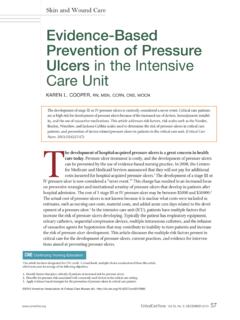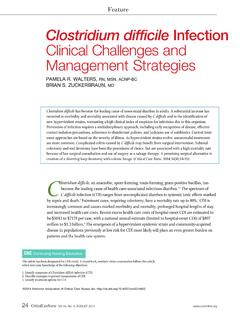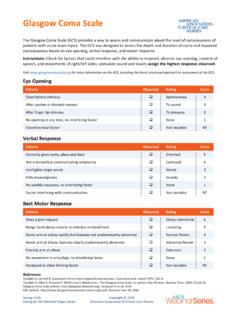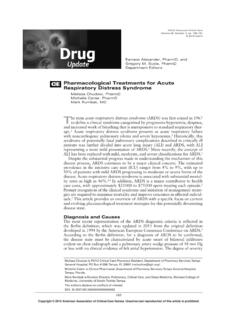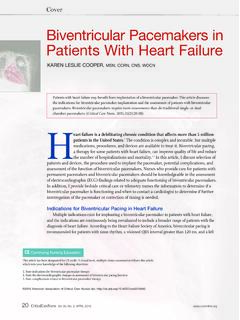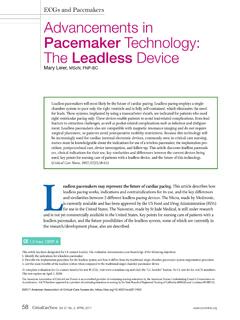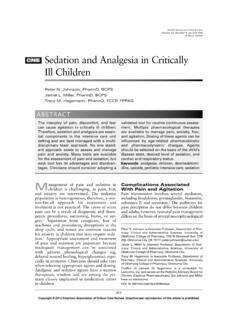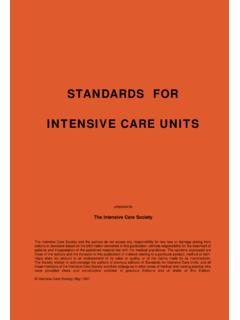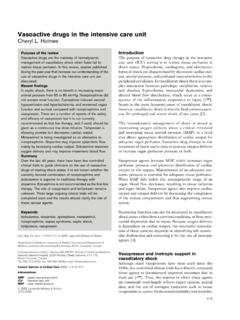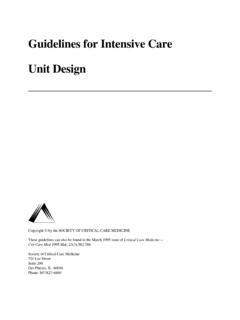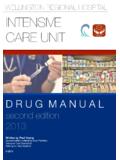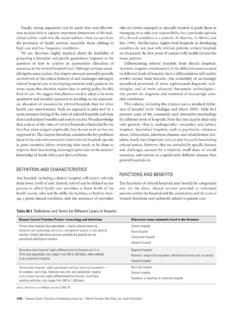Transcription of Continuous Renal Replacement Therapy: Case Vignettes
1 AACN Advanced Critical CareVolume 28, Number 1, pp. 64-73 2017 AACNDOI: Continuous Renal Replacement therapy : case VignettesCharlotte Garwood, RN, MS, CCRNCass Piper Sandoval, RN, MS, CCNSR obert Wonnacott, RN, MSNC raig Sadler, RN, BSNS usan Dirkes, RN, MSA, CCRNC harlotte Garwood is Registered Nurse 2, Medical Intensive Care Unit, Vanderbilt University Medical Center, 1211 Medical Center Dr, Nashville, TN 37232 Piper Sandoval is Clinical Nurse Specialist, Adult Critical Care, University of California, San Francisco Medical Center, San Francisco, Wonnacott is Senior Lead Nursing Informatics, Univer-sity of Michigan Health System, Ann Arbor, Sadler is Staff Nurse, University of Michigan Health System, Ann Arbor, Dirkes is Staff Nurse, University of Michigan Health System, Ann Arbor, authors declare no conflicts of interest.
2 Continuous Renal Replacement therapy (CRRT) is an option for management of fluid, electrolyte, metabolic, and acid-base disturbances related to either acute or chronic Renal disorders in critically ill patients. The broad subpopulations of critically ill patients present unique challenges to management of CRRT related to their critical cardiopul-monary status and/or the additional therapies common to the intensive care unit (ICU). This article presents 3 of these unique situa-tions to highlight CRRT management in a case vignette Vignette 1: RhabdomyolysisMr Z was a 63-year-old man admitted to the hospital for thoracic surgery following new findings of a mediastinal mass on the left side and pulmonary and periesophageal lesions on the right side. His medical history included a fibrosarcoma (treated 5 years ago), gastroesophageal reflux disease, depression, and obesity with a body mass index (BMI) of 41 (calculated by dividing his weight of 130 kg by his height of m squared).
3 Results of his preoperative urinalysis and his Renal function were normal, with a serum creatinine level of mg/dL (to convert to micromoles per liter, multiply by ). During the surgical ABSTRACTThe most common indication for Continuous Renal Replacement therapy (CRRT) in critically ill patients is acute kidney injury with hemo-dynamic instability. Typically, the patient has metabolic disturbances and potential or actual fluid overload that require intervention. Certain critical care diagnoses and/or conditions or therapies present unique CRRT management approaches. case Vignettes are used to pre-sent the unique management of CRRT in critically ill patients with rhabdomyolysis, heart failure, and respiratory failure requiring extracorporeal membrane : CRRT, ECMO, heart failure, rhabdo-myolysis, Continuous Renal Replacement ther-apy, extracorporeal membrane oxygenation64 VOLUME 28 NUMBER 1 SPRING 2017 CRRT case VIGNETTES65procedure, Mr Z was positioned left side down for the right thoracotomy and resection of lesions from the upper, middle, and lower lobes as well as the chest wall.
4 He was in the operating room for 12 hours, and intraopera-tive events included tachycardia with new-onset atrial fibrillation and episodes of intermittent hypotension. His arrhythmia resolved after treatment with esmolol, metoprolol, and ami-odarone, and the hypotension resolved with small doses of phenylephrine. He was extu-bated at the end of the case and transferred to the ICU for close laboratory results on admission to the ICU were notable for an increase in serum levels of creatinine, potassium, phosphorus, and creatine kinase. (See baseline and subsequent laboratory results in Table 1.) His urine out-put decreased to less than mL/kg per hour, and urinalysis results were positive for glu-cose, ketones, protein, and large amounts of hemoglobin. Microscopic examination of his urine revealed sediment and muddy brown casts from slough of tubular cells indicating acute tubular necrosis.
5 Standard treatment for rhabdomyolysis was started with a bicarbonate infusion and fluid resuscitation. Because of concern for further fluid overload and new signs of pulmonary edema, additional fluid resuscitation was contraindicated. Subsequent laboratory results revealed increases in the serum level of creatinine to mg/dL and creatine kinase to 39 463 U/L (to convert creatine kinase to microkatals per liter, multiply by ), and the nephrology service was consulted to assist with further management of his Renal dysfunction. Acute kidney injury (AKI) due to rhabdomyolysis was diagnosed and attributed to his prolonged immobilization in the operating room. The increase in serum creatinine level and the decrease in urine output in the early postop-erative period met the diagnostic criteria for AKI1 (Table 2).
6 A dialysis access catheter was inserted, and CRRT was initiated within 12 hours of his arrival in the is a potentially life-threatening condition that is a result of skeletal muscle breakdown and release of cytotoxic intracellular components into the VariablebCreatinine, mg/dLUrea nitrogen, mg/dLSodium, mmol/LPotassium, mmol/LChloride, mmol/LBicarbonate, mmol/LTotal calcium, mg/dLIonized calcium, mmol/LMagnesium, mg/dLPhosphorus, mg/dLCreatine kinase, U/LUrine output, daily mean, mL/hCRRT ultrafiltrate volume, mL/dPostoperative DayIntensive Care UnitHospital 5641528 9006 h After 46340At started within 12 h of admission to intensive care unitTable 1: Laboratory Values for Patient With RhabdomyolysisaAbbreviations: CRRT, Continuous Renal Replacement therapy ; CVVH, Continuous venovenous hemofiltration; WNL, within normal conversion factors: To convert creatinine to mol/L, multiply by ; to convert urea nitrogen to mmol/L, multiply by ; to convert total calcium to mmol/L, multiply by ; to convert magnesium to mmol/L, multiply by ; to convert phosphorus to mmol/L, multiply by ; to convert creatine kinase to kat/L, multiply by Blank spaces indicate variable was not Laboratory tests run on serum ET The cause of muscle injury may be related to direct trauma or compression, adverse effects of drugs, or other conditions such as malignant hyperthermia and ,3 Risk factors associated with rhabdo-myolysis are long-term use of lipid-lowering medications, surgery (length of time immo-bile), and morbid obesity (BMI > 40).
7 2 Mr Z had 2 of the risk factors, with his high BMI and prolonged surgical time in the lateral decubitus position most likely leading to secondary compression and symptoms of rhabdomyolysis are myalgia, muscle weakness, dark tea-colored urine, and serum creatine kinase levels greater than 5 times the upper limit of the normal The first serum level of creatine kinase (15 891 U/L) for Mr Z on admission to the ICU was well above 5 times the upper limit (388 U/L) for the laboratory at Mr Z s hospi-tal. Potential complications of rhabdomyolysis include electrolyte disturbances, metabolic acidosis, and The most common com-plication of rhabdomyolysis is AKI with an incidence of 13% to 55% and also an associ-ated increase in ,5,6 The release of cytotoxic intracellular components such as myoglobin, creatine kinase, phosphorus, and uric acid from injured myocytes results in endothelial injury, capillary leak, and third spacing of intravascular This cascade of injury leads to reduced Renal blood flow and direct nephron injury by the myoglobin and its breakdown The acidotic environment promotes crystallization of uric acid and cast formation in the Renal tubules leading to obstruction and further injury of the ,7.
8 8 Although no evidence-based guidelines are available for management of rhabdomyolysis, administration of intravenous fluids and bicarbonate to alkalinize the blood and Renal environment is standard first-line therapy to prevent AKI. Compared with stan-dard treatment for rhabdomyolysis, CRRT effectively reduces serum levels of myoglobin and creatinine, normalizes electrolyte levels, and reduces hospital length of stay; despite those benefits, the mortality rate is no lower with CRRT than with standard TreatmentImplementation of CRRT shortly after recognition and diagnosis of rhabdomyolysis and after bicarbonate fluid resuscitation is intended to prevent Renal injury. The CRRT mode implemented for Mr Z was Continuous venovenous hemofiltration (CVVH) with off-label use of a commercially available dialysate solution with concentrations of bicarbonate at 35 mEq/L and potassium at 4 mEq/L infused as Replacement fluid at 4 L/h (30 mL/kg per hour).
9 After 24 hours of CVVH therapy with 28 900 mL of ultrafiltrate removal, Mr Z s serum level of creatinine increased to mg/dL, creatine kinase level decreased to 14 564 U/L, and urine output decreased to 232 mL/d. The fluid balance order was initially to keep the fluid balance even (net even), yet after 24 hours, the order was changed to -25 mL/h to slowly remove excess volume that was mobilizing back from the extravascular (third spaces) to the intravascular space. After another full day of CVVH with 92 725 mL of ultrafiltrate removal, Mr Z s serum creatinine Stage123 One of the following is present:1. An increase in serum level of creatinine of * mg/dL within 48 hours2. An increase in serum level of creatinine to * times baseline within the preceding 7 days3. Urine volume ) mL/kg per hour for 6 hoursAKI Defining Criteria1 KDIGO Clinical Practice Guidelines for Staging of AKI1 Urine Output< mL/kg per hour for 6-12 h< mL/kg per hour for * 12 h< mL/kg per hour for * 24 h or anuria for * 12 hSerum Level of times baseline or * mg/dL times times baseline or * mg/dL or initiation of RRT or decreased eGFR to < 35 mL/min per m2 (patients < 18 years)Table 2: Definition and Staging of Acute Kidney Injury (AKI)Abbreviations: eGFR, estimated glomerular filtration rate; KDIGO, Kidney Disease: Improving Global Outcomes.
10 RRT, Renal Replacement 28 NUMBER 1 SPRING 2017 CRRT case VIGNETTES67level decreased to mg/dL, his level of creatine kinase decreased to 4677 U/L, and his urine output increased to 353 mL mode of CRRT recommended for myo-globin clearance in rhabdomyolysis is CVVH with high-volume ultrafiltration rates. Myo-globin has a low diffusion coefficient owing to its large molecular weight of 17 000 daltons and its nonspherical shape, so clearance is not achieved with intermittent and Continuous dialysis modes ( Continuous venovenous hemo-dialysis [CVVHD]) of Renal Replacement The mechanism of solute clearance during CVVH is convection, where high volumes of plasma water drag solutes of small and midrange molecular weight across the hemo-filter membrane to the effluent compartment with fluid removal.
